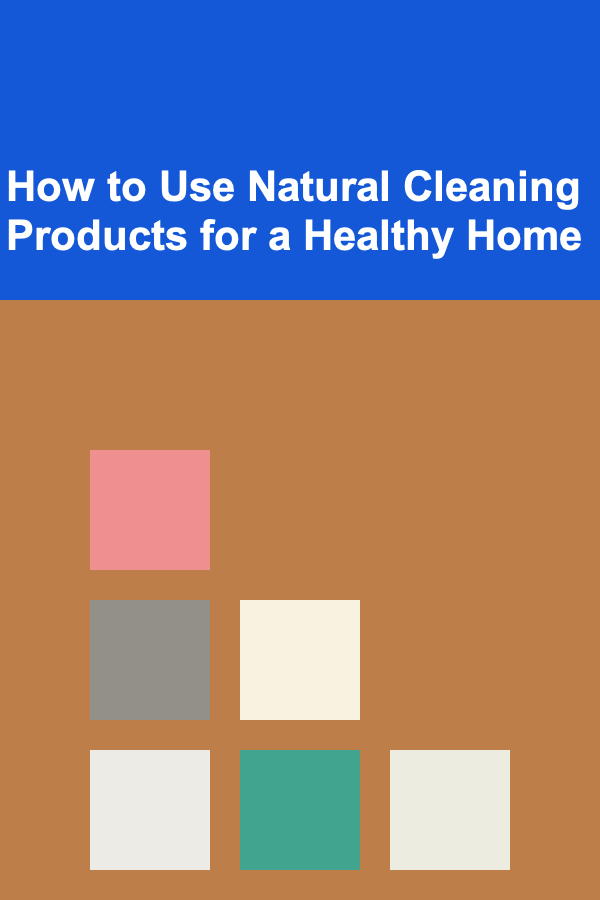
How to Use Natural Cleaning Products for a Healthy Home
ebook include PDF & Audio bundle (Micro Guide)
$12.99$5.99
Limited Time Offer! Order within the next:

In recent years, there has been a significant shift toward using natural cleaning products as people become increasingly aware of the potential health risks associated with conventional cleaning supplies. Traditional cleaning products often contain harsh chemicals that can contribute to indoor air pollution and pose various health risks, particularly for children and pets. This comprehensive guide will explore the benefits of natural cleaning products, provide recipes for effective homemade cleaners, and offer tips on transitioning to a healthier cleaning routine.
Understanding Natural Cleaning Products
1. What Are Natural Cleaning Products?
Natural cleaning products are made from ingredients derived from nature, including plant-based extracts, essential oils, and biodegradable substances. Unlike conventional cleaners that may contain synthetic fragrances and toxic chemicals, natural products emphasize transparency and safety.
2. Benefits of Using Natural Cleaning Products
- Healthier Indoor Air Quality: Natural cleaning products are less likely to release volatile organic compounds (VOCs) into the air, leading to better indoor air quality.
- Reduced Chemical Exposure: By using natural products, you minimize exposure to harmful chemicals that can cause respiratory issues, skin irritations, and other health problems.
- Environmental Impact: Many natural cleaning products are biodegradable, making them safer for the environment when washed down the drain.
- Cost-Effectiveness: Homemade natural cleaning solutions can be cheaper than store-bought alternatives, allowing you to save money while maintaining cleanliness.
3. Common Ingredients in Natural Cleaning Products
Understanding which ingredients are commonly used in natural cleaning products can help you make informed choices.
a. Vinegar
- Properties: Antimicrobial and acidic, making it effective at cutting through grease and mineral deposits.
- Uses: Ideal for disinfecting surfaces and removing odors.
b. Baking Soda
- Properties: Mild abrasive and deodorizing agent.
- Uses: Great for scrubbing surfaces and neutralizing odors.
c. Lemon Juice
- Properties: Natural antibacterial and bleaching agent with a fresh scent.
- Uses: Effective for cutting through grease and brightening surfaces.
d. Essential Oils
- Properties: Antimicrobial and aromatic, depending on the oil used.
- Uses: Enhance the fragrance of cleaning solutions while providing additional cleaning power.
e. Castile Soap
- Properties: Plant-based soap that is gentle yet effective.
- Uses: Can be used in various cleaning applications, from dishes to floors.
Transitioning to Natural Cleaning Products
Switching to natural cleaning products requires a bit of planning and mindset change. Here's how to effectively transition:
1. Assess Your Current Inventory
Begin by evaluating the cleaning products you currently use. Identify any items that contain harsh chemicals or artificial fragrances. Take note of what works well and what doesn't; this assessment will help you determine what homemade or natural alternatives you'll need.
2. Research Alternatives
Once you have a list of your current products, start researching natural alternatives. There are countless resources available online, including blogs, videos, and articles that provide insight into effective natural cleaning solutions.
3. Start Slowly
Transitioning doesn't have to happen overnight. Begin by replacing one or two conventional products with natural alternatives. For example, you might start with an all-purpose cleaner or a bathroom cleaner before moving on to laundry detergent or dish soap.
4. Make Your Own Cleaners
Creating your own natural cleaning products can often be more cost-effective and customizable to your preferences. It also allows you to control the ingredients involved.
5. Educate Others
If you live with family or roommates, communicate your plans to transition to natural cleaning products. Educating others about the benefits and reasons for the change can encourage collective participation and support.
Recipes for Homemade Natural Cleaners
Here are some simple and effective recipes for homemade natural cleaners using common household ingredients.
1. All-Purpose Cleaner
This versatile cleaner can be used on countertops, tables, and other surfaces.
Ingredients:
- 1 cup distilled white vinegar
- 1 cup water
- 10-15 drops of essential oil (e.g., lemon, tea tree, or lavender)
Instructions:
- Combine the vinegar and water in a spray bottle.
- Add the essential oil and shake gently to mix.
- Spray onto the surface and wipe clean with a cloth.
2. Glass Cleaner
Achieve streak-free windows and mirrors with this easy recipe.
Ingredients:
- 1 cup water
- 1 cup white vinegar
- 1 tablespoon cornstarch (optional, for extra shine)
Instructions:
- Mix all ingredients in a spray bottle.
- Shake well before each use.
- Spray onto glass surfaces and wipe with a microfiber cloth.
3. Bathroom Cleaner
This cleaner helps tackle soap scum and mildew effectively.
Ingredients:
- 1/2 cup baking soda
- 1/2 cup liquid Castile soap
- 10-15 drops of essential oil (e.g., eucalyptus or tea tree)
Instructions:
- In a bowl, combine the baking soda and Castile soap to form a paste.
- Add the essential oil and mix well.
- Apply to bathroom surfaces, let sit for a few minutes, and scrub with a sponge or brush.
4. Floor Cleaner
Keep your floors shining with this natural solution.
Ingredients:
- 1 gallon hot water
- 1 cup distilled white vinegar
- 5-10 drops of essential oil (e.g., lemon or orange)
Instructions:
- Mix all ingredients in a bucket.
- Mop floors as usual, ensuring to wring out the mop to avoid excess moisture.
5. Laundry Detergent
Make your own laundry detergent for a fresher, chemical-free alternative.
Ingredients:
- 1 bar of soap (grated)
- 1 cup washing soda
- 1 cup borax
- 10-15 drops of essential oil (e.g., lavender or lemon)
Instructions:
- Combine all ingredients in a large container.
- Use 1-2 tablespoons per load of laundry.
Tips for Using Natural Cleaning Products Effectively
To maximize the effectiveness of natural cleaning products, consider the following tips:
1. Read Labels and Follow Instructions
When using commercial natural cleaning products, always read labels carefully to understand their intended uses and any specific instructions.
2. Allow Time for Action
Many natural cleaners require more time to work compared to their chemical counterparts. For instance, let vinegar sit on surfaces for a few minutes to enhance its cleaning power.
3. Use Proper Tools
Utilize cleaning tools that complement your natural products. Microfiber cloths, soft bristle brushes, and mops designed for specific tasks can improve cleaning efficiency.
4. Test Surfaces First
Before applying any new cleaner to a surface, conduct a patch test in an inconspicuous area to ensure compatibility and avoid damage.
5. Maintain Regular Cleaning Habits
Natural cleaning products work effectively when used consistently. Create a cleaning schedule to maintain a tidy space and prevent buildup.
6. Store Safely
Always store homemade cleaners in clearly labeled containers. Keep them out of reach of children and pets to ensure safety.
Making Your Home Cleaner and Healthier
Using natural cleaning products not only helps maintain a clean home but also contributes to overall wellness. Here are some additional practices to promote a healthy living environment:
1. Improve Ventilation
Regularly ventilate your home by opening windows and doors to allow fresh air to circulate. This practice helps reduce indoor pollutants and enhances air quality.
2. Incorporate Houseplants
Houseplants can purify the air and add natural beauty to your home. Consider adding plants known for their air-cleaning properties, such as spider plants, snake plants, or peace lilies.
3. Practice Good Hygiene
Encourage good hygiene habits among household members, such as regular handwashing and frequent cleaning of high-touch surfaces.
4. Use Natural Air Fresheners
Instead of traditional air fresheners that can contain harmful chemicals, create your own natural air fresheners. For example, simmer cinnamon sticks, citrus peels, or herbs in water to infuse pleasant scents throughout your home.
5. Control Humidity Levels
Maintaining appropriate humidity levels prevents mold growth, which can be harmful to health. Use dehumidifiers in damp areas and ensure proper ventilation in bathrooms and kitchens.
Overcoming Challenges with Natural Cleaning Products
While transitioning to natural cleaning products offers numerous benefits, some challenges may arise. Here are tips to address common issues:
1. Effectiveness Concerns
Some consumers worry that natural cleaning products may not be as effective as chemical ones. To overcome this concern:
- Experiment with different combinations of natural ingredients until you find what works best for your home.
- Allow natural cleaners extra time to work on tough stains or buildup.
2. Scent Preferences
Not everyone enjoys the smell of vinegar or baking soda. To address scent preferences:
- Experiment with various essential oils to create custom fragrances that appeal to you.
- Use less potent natural fragrances if strong scents are a concern.
3. Time Investment
Making homemade cleaners may seem time-consuming initially. However, the time invested pays off in the long run when considering reduced health risks and cost-effectiveness.
- Prepare larger batches of cleaners to store for later use, reducing future prep time.
- Get the whole family involved in the cleaning process to share the workload.
4. Initial Costs
While many natural cleaning products are budget-friendly, some may require initial investments, such as essential oils or specialty ingredients.
- Start small by focusing on essential items like vinegar, baking soda, and Castile soap. Expand your collection gradually.
- Look for bulk buying options or sales to save money when purchasing natural ingredients.
Conclusion
Transitioning to natural cleaning products is a rewarding endeavor that promotes a healthier home environment. By understanding the benefits of natural ingredients, experimenting with homemade recipes, and adopting effective cleaning practices, you can create a safe and inviting space for yourself and your loved ones.
Embrace the power of nature in your cleaning routine, and enjoy the myriad advantages that come with using natural cleaning products. Not only will your home look and smell fresh, but you'll also foster a safer, healthier atmosphere conducive to well-being. Through consistent effort and mindful choices, you can take significant strides toward achieving a cleaner, greener, and healthier home.

How to Avoid Rental Property Scams
Read More
How to Create a Multi-Functional Entryway Space
Read More
How to Optimize Your Bedroom Layout for Clutter-Free Living
Read More
How to Protect Your Home from Pests with Preventative Maintenance
Read More
How to Stage Your Home for a Contemporary, Clean Look
Read More
How to Use Clipboards for Project Organization
Read MoreOther Products

How to Avoid Rental Property Scams
Read More
How to Create a Multi-Functional Entryway Space
Read More
How to Optimize Your Bedroom Layout for Clutter-Free Living
Read More
How to Protect Your Home from Pests with Preventative Maintenance
Read More
How to Stage Your Home for a Contemporary, Clean Look
Read More